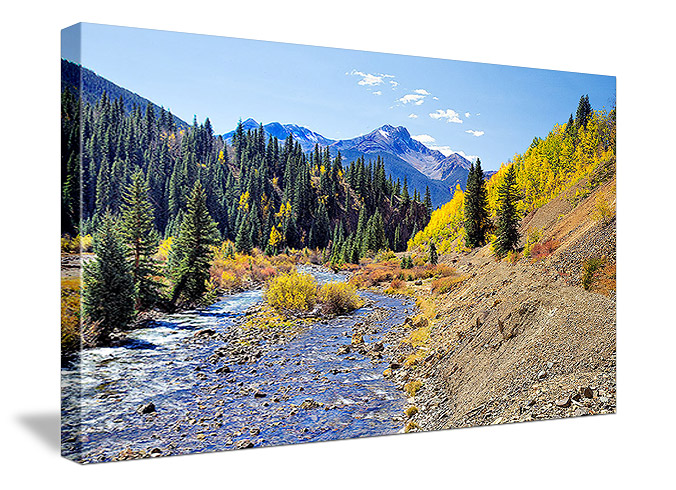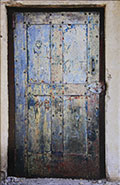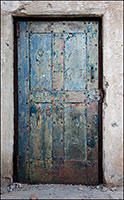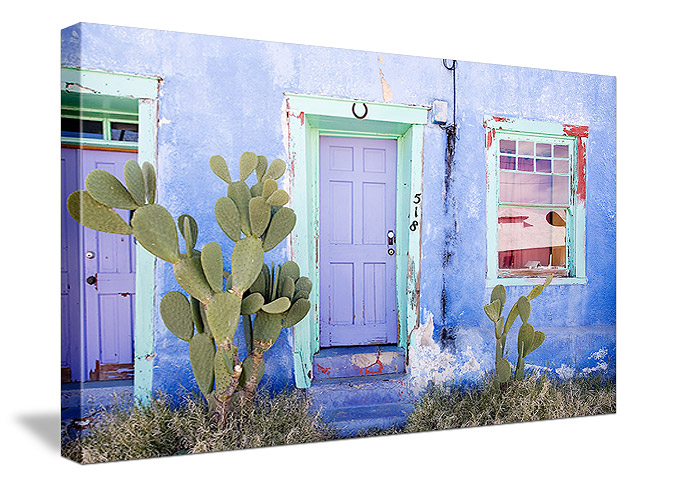Article by Bob Estrin
Printing Fine Art Photography on Canvas
Painters have been using this printing technology for many years:
You have probably seen painters paint on the front of a canvas and also on the sides. These paintings could hang directly on the wall just as they are without a frame. If you could not afford an original painting from the artist, many artists offer to sell you a reproduction print at a reduced price.
This same process that has already been used for many years for the reproduction of paintings is now also being used more for fine art photography.
For paintings, this is usually a photograph or scan of an original painting put into a digital file and then printed on canvas. For photography, this would be a scan of a negative or a direct digital file from a digital camera.
These canvas prints could be framed or stretched on thick wooden bars as a canvas wrap and sold. These are often referred to as a "Giclée" print, but other terms such as "pigment print" or "archival inkjet print" on canvas are used.
The images in this article are for sale, click any image for information.What is a gallery canvas wrap?
Gallery canvas Wrap is an artistic alternative to the way photography is traditional displayed. The photograph is printed on canvas with a extra white border to hold the staples. The canvas is then stretched so that the canvas wraps around all four of the sides and onto the back of the frame. The canvas is secured to the back of the wooden frame with staples. These staples do not show on the photographic image area on the front or sides. A good quality gallery wrap should be tight on the front with no sagging areas and the corner areas should be folded neat and flat as possible.
The area on the side also contains the photograph’s image and has a finished appearance even when viewed from the side. This method of stretching and preparing a canvas allows for a frame less presentation of a finished photograph.
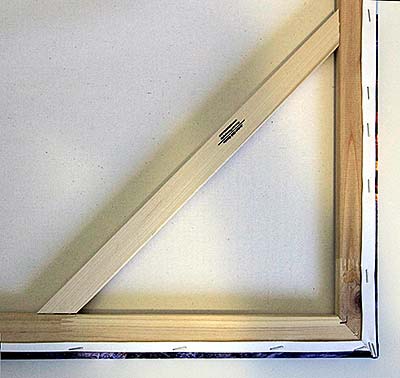 Back side of canvas showing wooden bars
Back side of canvas showing wooden bars
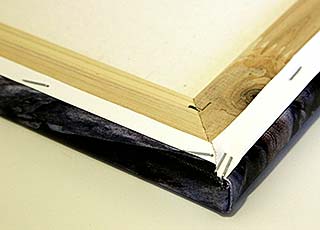 Detail of staples and corner wrap
Detail of staples and corner wrapAdvantages of having fine art photography printed as a canvas wrap:
- Canvas wrapped photographs have a unique look that is not available with regular frames. Because the photograph is printed on canvas, which has more of a woven texture, the photograph has more of an artistic look which is currently very popular. The canvas wrap can also appear three dimensional.
- Having a photograph printed on canvas and wrapped around a stretcher bars may be initially more expensive than printing on a traditional photo or inkjet paper but there is no need to have the additional expensive of a custom frame. A photograph printed as a gallery canvas wrap could even come out with a lower overall cost.
- A gallery canvas wrapped photograph is ready to hang. There is no need to go to a professional framer and make decisions on mats colors, frames styles and then find out how expensive frames can cost even with a discount coupon. Since canvas prints do not use glass, the photograph can be seen clearly without glare or reflection from the glass.
In the situation of very large photographs, in most cases the costs could be much less to get a gallery canvas wrapped photograph Vs framing.
If you normally purchase your frames ready-made in standard frame sizes, you can avoid expensive custom framing if you happen to purchase from an artist a matted photograph that falls within a standard size. In the situation of a gallery canvas wrap, the photograph can be any odd size and still hang on the wall as is. This allows the fine art photographer to compose the image as they would like without the need to fit traditional standard frame dimensions.
- The gallery canvas wrapped photographs are very light, even in very large sizes. This makes them easier to hang and without glass, easier to move without the fear of breaking. No special hanging tools are required; if the canvas wrap comes with traditional D rings and wired across the back; you can just use standard picture hangers.
- Cleaning can be done without damaging the photograph by dusting or using a lightly damp clean cloth. This is due to the sprayed or rolled on protective clear coating. This clear coating also protects the photograph from ultraviolet light and fading.
- Photographs printed using pigmented inks will last longer without fading than photographs printed on traditional photography paper. In In my opinion, all modern printing methods last a long time, some just last longer.
- Photographs printed on canvas can be printed larger than on paper with the same file resolution. Part of this is because of the texture of the canvas Vs the flat paper. Also, canvas prints are usually printed larger than prints on paper and are normally viewed from a further distance.
Canvas prints are usually printed at a lower resolution such as 150 DPI, while prints on paper use a much higher 300 DPI. In non-technical terms, you can go larger on canvas with the same resolution file or Megapixel camera.
Recent Advances in Print Technology:
There are many more ways to order fine art photography today than in the past. Traditional fine art photography was previously only available printed on photo paper that was processed in chemicals.

The advancement in inkjet printing technology within the last 10 years has been life-changing on how fine art photographers do their printing. Many advances have been made in higher quality printers, fade-resistant pigmented archival inks, and an assortment of quality printing papers. This has allowed individual photographers or commercial labs the freedom to print individual high-quality photography with superior color and detail at a lower cost. The higher-end printers usually come in sizes to print 17”, 24” or 44” wide and even longer lengths. Most fine art photographers use Epson printers, but both HP and Canon printers deliver excellent images.
Images printed on paper or canvas using an inkjet printer with archival inks will last even longer than traditional photographs. Images printed on canvas using the same process as printing on paper. Instead of putting paper into the inkjet printer, you place high-quality canvas that is developed to absorb the printer’s inks. When the inks dry, the canvas is then coated with a UV protective clear coating. This coating is usually sprayed or rolled on. This coating protects the photograph’s colors from fading from UV light. The coating also allows for cleaning the canvas surface with a clean damp cloth without damaging the image. After the coating dries, the canvas is stretched on wood bars.
Canvas printing options
Variety of canvas sizes:
Photographs can be offered in as many sizes in canvas as it can for noncanvas prints. Canvas prints can be small such as 11” x 14” or as large as 40” x 60”. Custom sizes can be made any size. Small canvas wrapped photographs will be much more expensive per square inch than larger canvas prints. This is due to the many production steps that are the same for smaller and larger canvas prints. Medium or large-sized canvas wrapped prints are much more cost-effective.
I just sent in an order for a customer for a 30”x45” canvas wrap print with 1.5-inch sides. While the actual size of the front of the canvas wrap print will be 30”x45”, the actual print on canvas will need to be larger to account for the wrapping. The actual printed image area will be 33.5” x 48.5” when laid flat before it is stretched on the wooden structure.
This additional printing area is another reason that canvas wrapped prints cost more. Most customers are not aware that the actual print size is larger because photographers list the size of the canvas front for simplicity.
Variety of canvas widths:
Depending on what the printer or the artist is offering, you may have the choice of different thicknesses on the side of your gallery wrap. Many common thicknesses are ¾ or 1 inch (Thin), 1.5 or 2 inches (Thick) or 2.75+ inch (You want to make a statement). For prints 20" x 30" or smaller, thin sides are fine. For larger sizes, I feel 1.5 or 2-inch sides look better and provide stronger wooden frame support for larger pieces of art. The canvas wrap thickness is a personal choice for any size print but it should be taken into consideration of what important part of the image will fall on the canvas sides that you may prefer to be on the front.
Image wrapped around the sides, solid black sides or mirrored sides:
An example of a gallery wrap print with the image printed around the sides is shown at the top and of the blue door with cactus below.
Besides the thickness, the photographer or your printer may also offer the option to have the sides of the gallery wrap colored in a solid color such as the popular black. When the canvas sides are black they do not cover up any of the image areas, the image is displayed in full on the canvas front. Having black color printed on all four sides also has a very nice bordered or frame look when viewing the canvas wrap from the sides. See sample print of Mesa Arch below with black sides. Other side colors such as white or a matching color to the image may also be available.If you take the option of having solid color sides, if you later decide to place an optional frame around the canvas print, you will not be covering up any of the image areas since none of the photographic image was ever printed on the sides. I recommend having black sides when the canvas font size is smaller than 16" x 20". On the smaller prints, having the image wrap around the sides may not be best when important areas to the composition of the photograph are near the edges.
If those areas are on the sides hold image area important to the composition, the image may appear to be too tightly cropped when viewed from the front. This is not as much of an issue on larger prints. The amount of image displayed on the side will also increase with the thicker edges such as 1.5" or 2.5" wraps.
In the door images below, the small canvas print on the left with 3/4 inch sides seems tightly cropped. The rest of the image area is on the wrapped sides which are not visible from the front. The entire image is shown on the right. If this image used the option of black on the sides, it would look more similar to the door image on the right with the original composition.Another gallery wrap image option is to have the sides show a mirror image of part of the images showing on the front. If you have 1.5" borders, the printer will duplicate 1.5" areas on all four sides. You can see an example shown on the canyon photography below. This works for any images that you do not wish to crop any of the picture areas from showing on the front. On some images that have strong repeating lines such as the canyon image example below, the mirrored side sections are more noticeable and may not be the best choice from those images. In most cases, you do not see the mirrored effect once it is on the wall.
Even if a fine art photographer doesn't offer gallery wrap, mirror wrap, or black side options on their website, you can always call them and ask. Many times, it is difficult to add so many custom options on the website but that does not mean that these options are not available.
Shipping costs:
While some of this shipping information can apply to non-canvas photography orders, it is still good information to know. In the situation in which you are having the fine art photographer mail you a single very large canvas print, you may want to consider a different method listed below. Many times shipping large canvas prints can be very expensive since they could be oversized if over 20”x30”. If you are ordering multiple large canvas prints, it may be more cost-effective to ship them together on stretcher bars.
If ordering just one large canvas print, it can be better to ask the photographer to mail you only the canvas print without the wooden stretcher bars. The “print only” cost should be less than the finished stretched canvas price. These prints can be rolled up in a strong cardboard tube and arrive safely at your home.
You can then just bring the canvas print to your local framer and ask for it to be stretched on a wooden frame. The results will be the same in the end, and the cost of the local stretching will be less than what you saved on the “print only” price and the greatly reduced shipping cost in many cases.
Another advantage of having the fine art photographer mail you the photographs is that if you ship over State lines, the photographer does not have to charge the customer sales tax which is over 9% where I live. This can make up for much of the shipping cost on an expensive canvas purchase.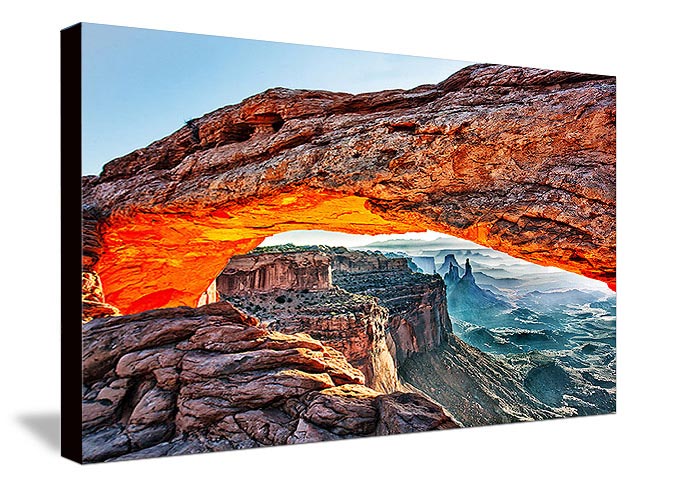
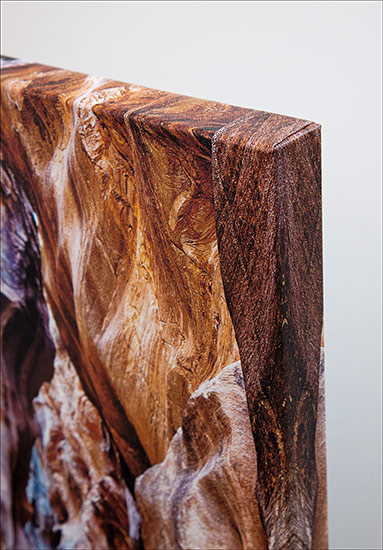
Gallery wrap with black sides and gallery wrap with image mirrored on sides
Should you get a gallery wrap?It always comes out to personal choice of what looks you prefer. As a professional fine art photographer, I like having different print options as part of my creative process. Canvas printing is one more way I can offer my customers custom choices at a competitive price when compared to the cost of a traditional framed print.
I feel that if you get a canvas print and see it on your wall, you will love it.
The images in this article are for sale, click any image for more information or visit one of my galleries above to see additional art.
Sign up to my Twitter account below and be the first to see any new photographs I am working on (only a few tweets a week).
Bob Estrin
Articles for artist:
1. Selling your art at an art show2. The artist relationship with the alternative art gallery and artist/gallery contracts
3. The artist reception - A social event or a business opportunity
4. Artist printing photography on canvas
5. DIY project on mounting metal prints to the wall
6. Printing photography on different surfaces and presentations
7. Photography career paths for photography students
Articles for artist selling online at Amazon:
1. Selling your art or artisan craft on Amazon
3. Handmade at Amazon - Powerful Bulk editing step by step instructions for your Handmade items
4. Handmade at Amazon - New Handmade SPF seller fulfilled Prime program
Articles on Web Security:
1. Internet password hints for a more secure internet experience
2. How artist can protect themselves from internet scam orders
Articles for photographers:
1. Cleaning your digital sensor2. Photographing Antelope Canyon, Utah's best slot canyon
www.bobestrin.com
Copyright 2011 Bob Estrin
Feel free to link to this article from your non commercial web site.
